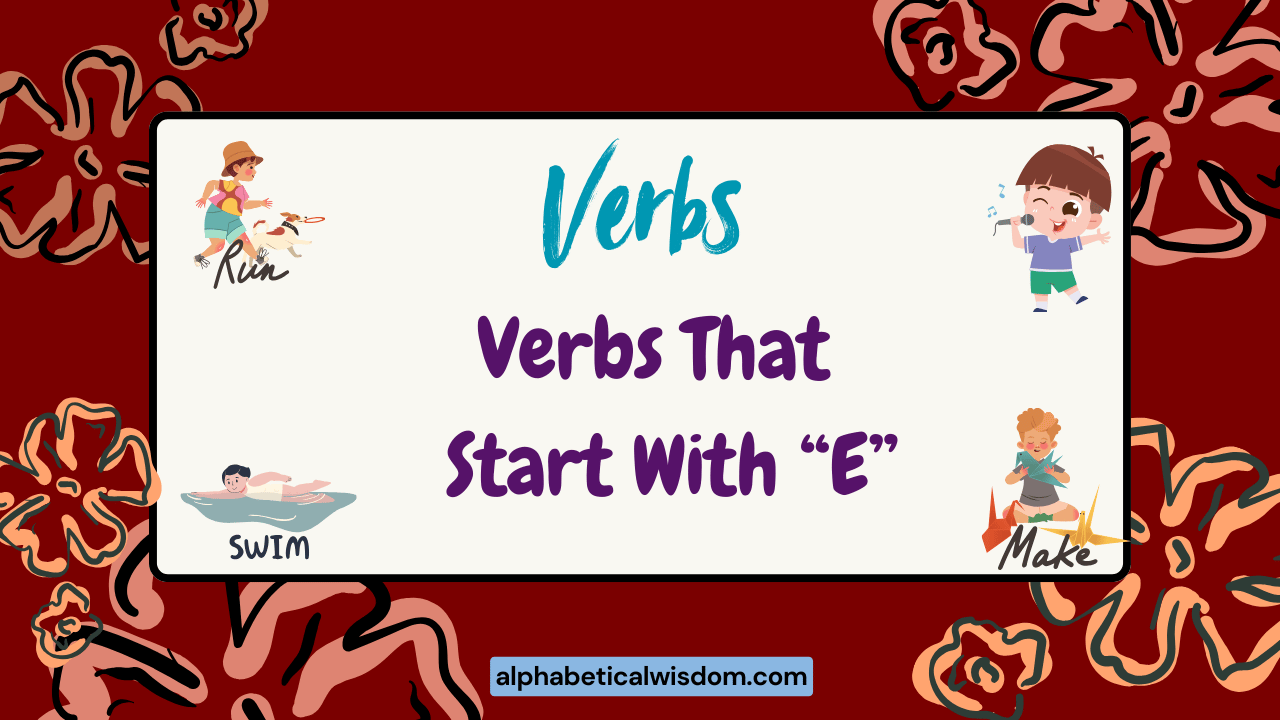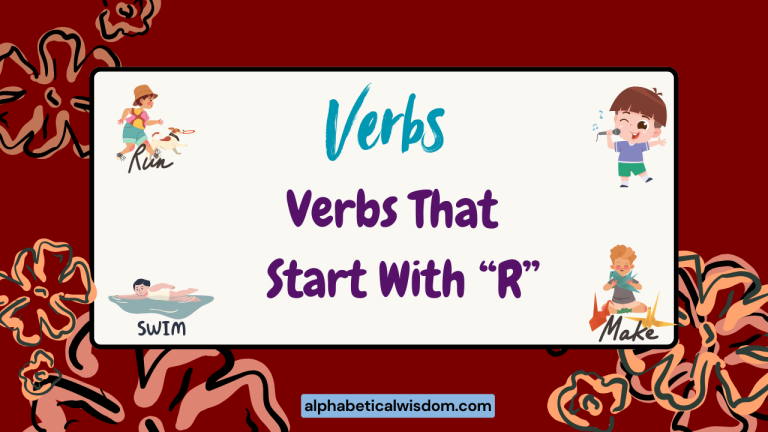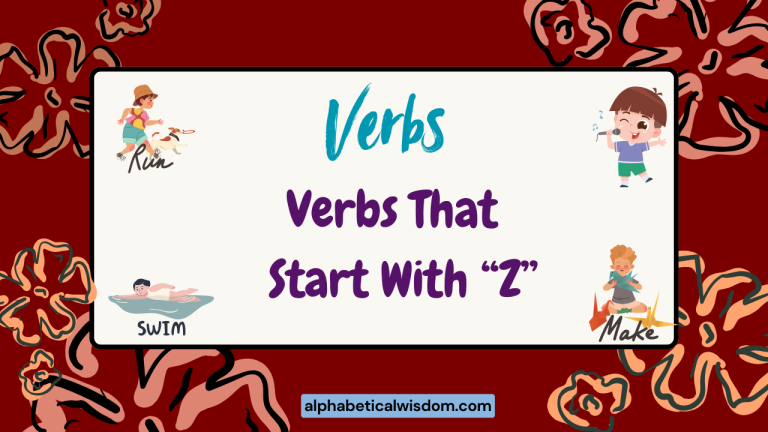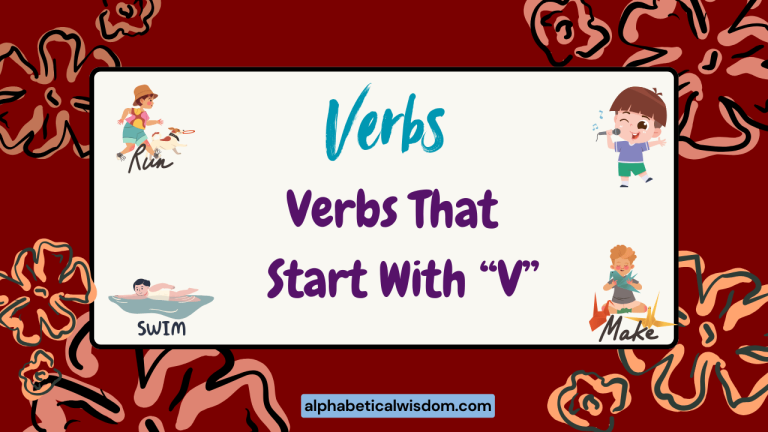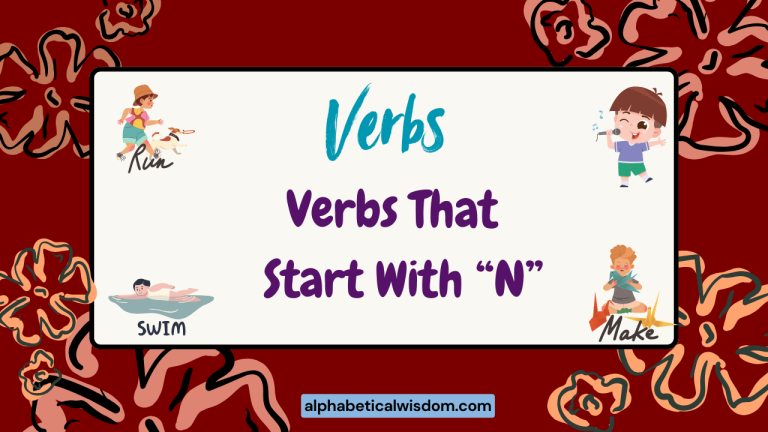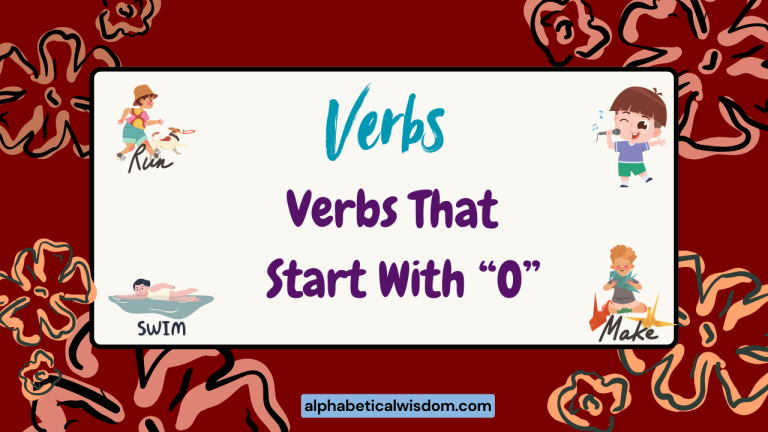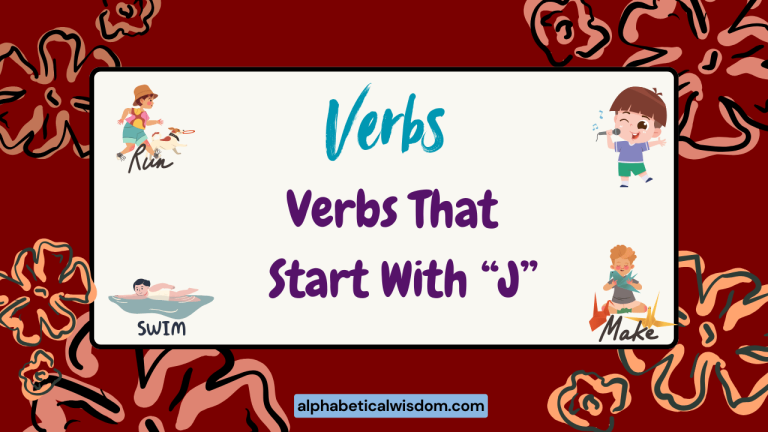Verbs That Start With E: A Comprehensive Grammar Guide
Verbs are the engines of sentences, driving action and expression. Mastering verbs, especially those starting with ‘E’, is crucial for precise and dynamic communication in English.
This guide offers a thorough exploration of ‘E’ verbs, enhancing your ability to use English effectively. Whether you’re a student, a language enthusiast, or a professional aiming for polished communication, this article will provide the knowledge and practice you need to confidently wield these powerful words.
Table of Contents
- Introduction
- Definition of Verbs Starting With ‘E’
- Structural Breakdown
- Types and Categories of ‘E’ Verbs
- Examples of ‘E’ Verbs in Sentences
- Usage Rules for ‘E’ Verbs
- Common Mistakes with ‘E’ Verbs
- Practice Exercises
- Advanced Topics
- Frequently Asked Questions (FAQ)
- Conclusion
Definition of Verbs Starting With ‘E’
Verbs that start with ‘E’ are words that denote actions, occurrences, or states of being, with their initial letter being ‘E’. Like all verbs, they are essential components of sentences, serving as the predicate and indicating what the subject is doing or experiencing.
These verbs can be classified based on their function (action, linking, auxiliary), their transitivity (transitive, intransitive), and their conjugation patterns (regular, irregular).
The function of an ‘E’ verb is to express an action (e.g., eat, explore), a state of being (e.g., exist, embody), or an occurrence (e.g., erupt, emerge). These verbs contribute significantly to the dynamic nature of language, allowing us to describe a wide array of activities, conditions, and processes. Understanding the nuances of these verbs is crucial for both comprehension and effective communication.
The context in which an ‘E’ verb is used determines its specific meaning and grammatical behavior. For example, the verb “eat” can describe a simple act of consuming food, or it can be used metaphorically to describe being consumed by something, such as “The pressure was eating him alive.” Therefore, paying close attention to the surrounding words and the overall situation is essential for interpreting the intended meaning.
Structural Breakdown
The structure of verbs starting with ‘E’ follows the general rules of English verb conjugation. They have different forms to indicate tense (past, present, future), aspect (simple, continuous, perfect), and mood (indicative, imperative, subjunctive).
Understanding these forms and how they are created is essential for using ‘E’ verbs correctly.
The base form of the verb is the infinitive without “to” (e.g., eat, enter, establish). From this base form, other forms are derived.
For regular verbs, the past tense and past participle are formed by adding “-ed” (e.g., ended, erased). However, many ‘E’ verbs are irregular and have unique past tense and past participle forms (e.g., eat – ate – eaten).
Familiarizing yourself with these irregular forms is crucial for accurate grammar.
Here’s a breakdown of how ‘E’ verbs are typically conjugated in different tenses:
- Present Simple: I/You/We/They eat; He/She/It eats
- Past Simple: I/You/He/She/It/We/They ate
- Future Simple: I/You/He/She/It/We/They will eat
- Present Continuous: I am eating; You/We/They are eating; He/She/It is eating
- Past Continuous: I/He/She/It was eating; You/We/They were eating
- Present Perfect: I/You/We/They have eaten; He/She/It has eaten
- Past Perfect: I/You/He/She/It/We/They had eaten
- Future Perfect: I/You/He/She/It/We/They will have eaten
Types and Categories of ‘E’ Verbs
‘E’ verbs, like all verbs, can be categorized based on their function, transitivity, and regularity. Understanding these categories will help you use ‘E’ verbs more effectively.
Action Verbs
Action verbs describe physical or mental actions. These verbs are dynamic and show what the subject of the sentence is doing.
Examples of action verbs starting with ‘E’ include: eat, exercise, explore, erupt, enter, embrace, earn, elect, eliminate, email, embark, employ, empower, encourage, endanger, enforce, engage, enjoy, enlarge, enlighten, enlist.
Linking Verbs
Linking verbs connect the subject of a sentence to a noun or adjective that describes or renames the subject. They do not show action but rather establish a relationship.
Examples of linking verbs starting with ‘E’ include: exist, equal, embody, emulate.
Auxiliary Verbs
Auxiliary verbs, also known as helping verbs, assist the main verb in a sentence to express tense, mood, or voice. They do not carry the main meaning but rather provide grammatical support.
The most common auxiliary verbs are forms of “be,” “have,” and “do.” While “E” verbs are not typically used as primary auxiliary verbs, they can sometimes function in similar ways in specific constructions. For example, “endeavor” can be used with “to” followed by another verbs, acting as a sort of auxiliary to express effort or intention.
Transitive Verbs
Transitive verbs require a direct object to complete their meaning. The action of the verb is performed on the object.
Examples of transitive verbs starting with ‘E’ include: eat (something), erase (something), elect (someone), employ (someone), encourage (someone), endanger (something), enforce (something), engage (someone), enjoy (something), enlarge (something), enlighten (someone), enlist (someone).
Intransitive Verbs
Intransitive verbs do not require a direct object. The action of the verb is complete in itself.
Examples of intransitive verbs starting with ‘E’ include: exist, erupt, emerge, escape, expire, excel, emigrate, evolve.
Regular Verbs
Regular verbs form their past tense and past participle by adding “-ed” to the base form.
Examples of regular verbs starting with ‘E’ include: end (ended), erase (erased), earn (earned), employ (employed), encourage (encouraged), endanger (endangered), enforce (enforced), engage (engaged), enjoy (enjoyed), enlarge (enlarged), enlighten (enlightened), enlist (enlisted).
Irregular Verbs
Irregular verbs do not follow the regular “-ed” pattern for forming their past tense and past participle. They have unique forms that must be memorized.
Examples of irregular verbs starting with ‘E’ include: eat (ate, eaten), exist (existed, existed – although ‘existed’ is regular, the concept of ‘existence’ itself is often considered an irregular case in philosophical contexts), elect (elected, elected – follows the regular pattern but can be used in irregular ways contextually). While fewer common irregular ‘E’ verbs exist, it’s important to note that several verbs, while technically regular, can be used in idiomatic expressions that might seem irregular.
Examples of ‘E’ Verbs in Sentences
This section provides extensive examples of ‘E’ verbs used in various contexts. The examples are organized by category to illustrate the different ways these verbs can be used.
Action Verbs Examples
The following table provides examples of action verbs starting with ‘E’ used in sentences.
| Verb | Sentence |
|---|---|
| Eat | I eat breakfast every morning. |
| Exercise | She exercises regularly to stay healthy. |
| Explore | They explored the ancient ruins. |
| Erupt | The volcano erupted violently. |
| Enter | Please enter the room quietly. |
| Embrace | They embraced each other warmly. |
| Earn | He earned a lot of money last year. |
| Elect | The people elected a new president. |
| Eliminate | We need to eliminate all unnecessary expenses. |
| I will email you the document later. | |
| Embark | They embarked on a new adventure. |
| Employ | The company employs over 200 people. |
| Empower | Education can empower individuals. |
| Encourage | We should encourage each other. |
| Endanger | Pollution can endanger wildlife. |
| Enforce | The police enforce the law. |
| Engage | They engaged in a lively debate. |
| Enjoy | I enjoy listening to music. |
| Enlarge | Please enlarge the image. |
| Enlighten | The lecture enlightened the students. |
| Enlist | He enlisted in the army. |
| Evade | The criminal tried to evade the police. |
| Evaluate | The teacher will evaluate the students’ work. |
| Evaporate | The water will evaporate in the sun. |
| Evolve | Life on Earth continues to evolve. |
| Examine | The doctor will examine the patient. |
| Exceed | His performance exceeded expectations. |
| Exchange | They exchanged gifts. |
Linking Verbs Examples
The following table provides examples of linking verbs starting with ‘E’ used in sentences. Note that “exist” is often debated as a linking verb, but it can function as one in certain philosophical or existential contexts.
| Verb | Sentence |
|---|---|
| Exist | The possibility of life on other planets exists. |
| Equal | Two plus two equals four. |
| Embody | She embodies grace and intelligence. |
| Emulate | Young athletes often try to emulate their heroes. |
Transitive and Intransitive Verbs Examples
This table shows how some ‘E’ verbs can be either transitive or intransitive depending on the context.
| Verb | Transitive Sentence | Intransitive Sentence |
|---|---|---|
| Eat | I eat apples every day. | We eat at noon. |
| Erupt | (Less Common) The news erupted chaos throughout the office. | The volcano erupted yesterday. |
| Evolve | The company evolved its strategy to meet market demands. | Life evolves over millions of years. |
| Escape | The prisoner escaped the jail. | He escaped quickly. |
| Employ | The company employs many people. | (Less Common) The strategy employs for maximum efficiency. |
Regular and Irregular Verbs Examples
The following table highlights the different forms of regular and irregular ‘E’ verbs.
| Verb | Past Simple | Past Participle | Regular/Irregular |
|---|---|---|---|
| Eat | Ate | Eaten | Irregular |
| End | Ended | Ended | Regular |
| Erase | Erased | Erased | Regular |
| Employ | Employed | Employed | Regular |
| Exist | Existed | Existed | Regular |
Usage Rules for ‘E’ Verbs
Using ‘E’ verbs correctly involves following the standard rules of English verb conjugation, tense, and agreement. Here are some key rules to keep in mind:
- Subject-Verb Agreement: The verb must agree in number with the subject. For example, “He eats” (singular) vs. “They eat” (plural).
- Tense Consistency: Maintain consistent tense within a sentence or paragraph. Avoid unnecessary shifts in tense.
- Correct Form: Use the correct form of the verb (base form, past simple, past participle) according to the tense and aspect.
- Transitive vs. Intransitive: Ensure that transitive verbs have a direct object and intransitive verbs do not.
- Use of Auxiliary Verbs: Use auxiliary verbs (“be,” “have,” “do”) correctly to form different tenses and aspects.
Exceptions and Special Cases:
- Some ‘E’ verbs have multiple meanings, and their usage can vary depending on the context. For example, “engage” can mean “to participate” or “to hire.”
- Idiomatic expressions often use ‘E’ verbs in unique ways. For example, “eat your words” does not literally mean consuming words.
- Certain ‘E’ verbs, such as “endeavor,” are more formal and are typically used in formal writing or speech.
Common Mistakes with ‘E’ Verbs
Here are some common mistakes that learners make when using ‘E’ verbs, along with corrections:
| Incorrect | Correct | Explanation |
|---|---|---|
| He eat breakfast. | He eats breakfast. | Subject-verb agreement (singular subject “he” requires singular verb “eats”). |
| I am eat now. | I am eating now. | Correct form of the present continuous tense (using the “-ing” form). |
| Yesterday, I eat dinner late. | Yesterday, I ate dinner late. | Correct past simple form of “eat” (irregular verb). |
| She enjoys to swim. | She enjoys swimming. | “Enjoy” is followed by a gerund (“-ing” form). |
| They are encourage by the news. | They are encouraged by the news. | Correct past participle form of “encourage” in the passive voice. |
| I have eat all the cake. | I have eaten all the cake. | Correct past participle form of “eat” with “have”. |
| He is excite about the trip. | He is excited about the trip. | Correct past participle form of “excite” used as an adjective. |
| I expect that he will calling me. | I expect that he will call me. | Correct form of the verb after “will”. |
| She enter to the room. | She entered the room. | “Enter” does not need the preposition “to”. |
| They are embark in a new project. | They are embarking on a new project. | Correct preposition to use with “embark”. |
Practice Exercises
Test your understanding of ‘E’ verbs with these practice exercises. Each exercise focuses on a different aspect of verb usage.
Exercise 1: Choose the Correct Verb Form
Choose the correct form of the verb in parentheses to complete each sentence.
| Question | Answer |
|---|---|
| 1. I usually (eat/eats) breakfast at 7 AM. | eat |
| 2. Yesterday, I (eat/ate) a big lunch. | ate |
| 3. She (enjoy/enjoys) playing the piano. | enjoys |
| 4. They (explore/explored) the forest last summer. | explored |
| 5. The volcano (erupt/erupted) suddenly. | erupted |
| 6. He (earn/earned) a lot of money this year. | earned |
| 7. We (elect/elected) him as our leader. | elected |
| 8. The company (employ/employs) many people. | employs |
| 9. Education can (empower/empowers) individuals. | empower |
| 10. They (encourage/encouraged) me to pursue my dreams. | encouraged |
Exercise 2: Fill in the Blanks with the Correct Tense
Fill in the blanks with the correct tense of the verb in parentheses.
| Question | Answer |
|---|---|
| 1. I (eat) dinner when you called. | was eating |
| 2. She (exercise) every day to stay fit. | exercises |
| 3. They (explore) the cave next week. | will explore |
| 4. The volcano (erupt) several times in the past. | has erupted |
| 5. He (enter) the room quietly. | entered |
| 6. We (embark) on a new journey soon. | will embark |
| 7. The company (expand) its business rapidly. | is expanding |
| 8. She (excel) in her studies since childhood. | has excelled |
| 9. They (exchange) gifts every Christmas. | exchange |
| 10. The evidence (establish) his innocence. | established |
Exercise 3: Identify Transitive and Intransitive Verbs
Identify whether the ‘E’ verb in each sentence is transitive or intransitive.
| Sentence | Transitive/Intransitive |
|---|---|
| 1. She eats apples every day. | Transitive |
| 2. The volcano erupted violently. | Intransitive |
| 3. He employs many people. | Transitive |
| 4. They exist peacefully. | Intransitive |
| 5. The company expanded its operations. | Transitive |
| 6. She emigrated to Canada. | Intransitive |
| 7. He erased the mistake. | Transitive |
| 8. The bird escaped from its cage. | Intransitive |
| 9. They embrace new challenges. | Transitive |
| 10. The idea evolved over time. | Intransitive |
Advanced Topics
For advanced learners, here are some more complex aspects of ‘E’ verb usage:
- Subjunctive Mood: Using ‘E’ verbs in the subjunctive mood to express wishes, suggestions, or hypothetical situations (e.g., “I suggest that he eat less sugar”).
- Phrasal Verbs: Understanding and using phrasal verbs that start with ‘E’ (e.g., “end up,” “eat away”).
- Figurative Language: Recognizing and interpreting the use of ‘E’ verbs in metaphors, similes, and other figures of speech.
- Formal vs. Informal Usage: Distinguishing between formal and informal uses of ‘E’ verbs and choosing the appropriate register for different contexts.
Frequently Asked Questions (FAQ)
Here are some frequently asked questions about using ‘E’ verbs:
- Q: How do I know if an ‘E’ verb is transitive or intransitive?
A: A transitive verb takes a direct object, which receives the action of the verb. If you can ask “verb + whom/what?” and get a sensible answer, it’s transitive. If not, it’s intransitive. For example, “She eats apples” (eats what? apples – transitive) vs. “She eats at noon” (eats what? doesn’t make sense – intransitive).
- Q: What is the difference between “end” and “finish”?
A: Both “end” and “finish” mean to bring something to a conclusion. “End” often refers to a more natural or predetermined conclusion, while “finish” implies completing a task or activity. For example, “The movie ended” vs. “I finished my homework.”
- Q: How do I use “engage” correctly in different contexts?
A: “Engage” can mean “to participate” (intransitive), “to hire” (transitive), or “to attract” (transitive). Pay attention to the surrounding words to determine the intended meaning. For example, “They engaged in a debate” (participated), “The company engaged a consultant” (hired), “The speaker engaged the audience” (attracted).
- Q: What are some common phrasal verbs with ‘E’?
A: Some common phrasal verbs with ‘E’ include “end up” (to eventually reach a state or place), “eat away” (to gradually destroy or erode), “ease off” (to reduce in intensity), and “eke out” (to make something last by using it sparingly). Phrasal verbs often have meanings that are different from the individual words, so it’s important to learn them as separate units.
- Q: How do I improve my vocabulary of ‘E’ verbs?
A: Read widely, use a dictionary and thesaurus, and practice using new verbs in sentences. Pay attention to how native speakers use ‘E’ verbs in different contexts. Flashcards and vocabulary-building apps can also be helpful.
- Q: Are there any ‘E’ verbs that are often confused with other words?
A: Yes, “elicit” and “illicit” are often confused. “Elicit” means to draw out or evoke (a response or information), while “illicit” means illegal or forbidden. Also “emigrate” and “immigrate” can be confusing. Emigrate means to leave one’s country to live in another, while immigrate means to come to a country to live there.
- Q: How can I avoid making mistakes with irregular ‘E’ verbs?
A: Memorize the principal parts (base form, past simple, past participle) of irregular verbs. Use flashcards, online quizzes, and practice exercises to reinforce your knowledge. Pay attention to how irregular verbs are used in context.
- Q: What is the difference between “ensure”, “assure”, and “insure”?
A: “Ensure” means to guarantee or make certain. “Assure” means to tell someone something positively to dispel any doubts. “Insure” means to protect against risk by paying a premium. For example: “I will ensure that the package arrives on time.” “I assure you that I am telling the truth.” “I need to insure my car.”
- Q: When should I use the subjunctive mood with ‘E’ verbs?
A: The subjunctive mood is used to express wishes, suggestions, requirements, or hypothetical situations. It is often used after verbs like “suggest,” “recommend,” “demand,” and “insist.” For example, “I suggest that he eat less sugar,” or “It is essential that she be on time.” Note the use of the base form of the verb in the subjunctive.
- Q: How do I know which preposition to use with certain ‘E’ verbs?
A: Prepositions often depend on the specific verb and the intended meaning. There are no hard and fast rules, so it’s best to learn these combinations through exposure and practice. For example, “embark on a journey,” “excel in a subject,” “escape from prison.” Pay attention to these collocations when you read and listen to English.
- Q: How can I make my writing more engaging using ‘E’ verbs?
A: Use strong and vivid ‘E’ verbs to describe actions and states. Avoid passive voice and choose active verbs that create a more direct and impactful message. For example, instead of “The ball was eaten by the dog,” write “The dog ate the ball.” Use a thesaurus to find more descriptive and nuanced ‘E’ verbs.
Conclusion
Mastering verbs that start with ‘E’ is essential for effective communication in English. This guide has provided a comprehensive overview of their definition, structure, types, usage rules, and common mistakes.
By understanding these concepts and practicing regularly, you can significantly improve your English grammar and fluency.
Remember to pay attention to subject-verb agreement, tense consistency, and the correct use of transitive and intransitive verbs. Practice using new ‘E’ verbs in sentences and be mindful of their specific meanings and contexts.
With consistent effort, you can confidently and accurately use ‘E’ verbs to express yourself effectively.
Continue to expand your vocabulary, practice regularly, and seek out opportunities to use ‘E’ verbs in real-world conversations and writing. The more you practice, the more natural and fluent your English will become.
Good luck on your language learning journey!
